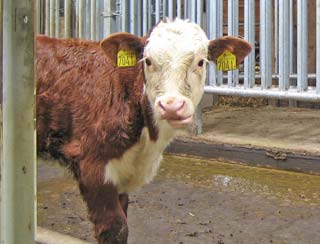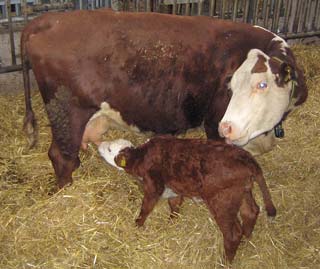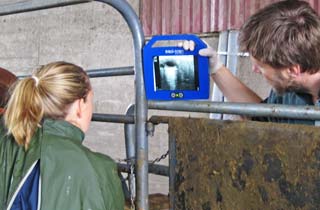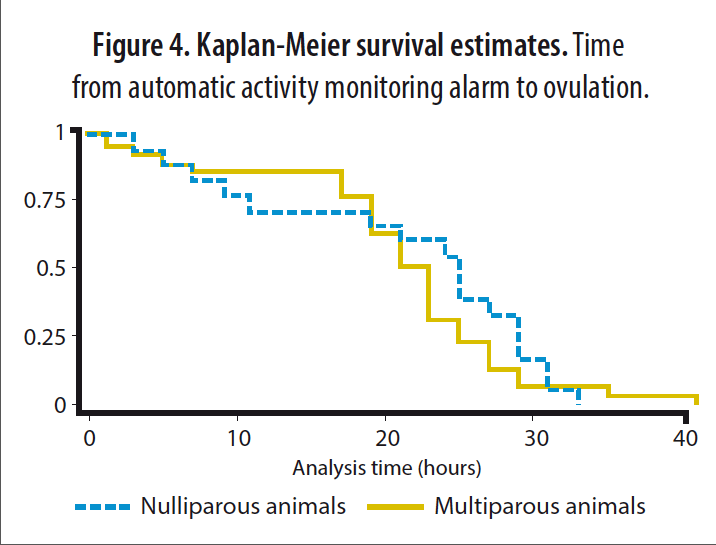30 Jan 2017
Adam Martin describes how modern techniques have answered beef suckler farmers’ concerns about using artificial insemination.

Towards the end of the last century the Food and Agriculture Organization of the United Nations stated the increases in milk production seen in the 20th century, achieved through genetic improvement, were greater than the increases in production that could be attributable – all other factors combined.

That really was an incredible statement: it meant genetic improvements alone were responsible for productivity increases greater than all improvements in health, nutrition, housing and so on combined. While the study of genetics laid the foundations for this, it was AI that brought about the change. Despite the huge advances made in the dairy industry through effective use of genetics, the beef industry has been relatively slow to use widespread AI to maximise
genetic improvement (Figure 1).
The picture is a little bit more complicated, of course. Dairy cow production is routinely recorded, which provides an accurate source of data on which to base breeding value calculations. Similar data in the beef industry are limited. This difference can be seen when looking in breeding catalogues. The reliability of dairy bulls’ predicted breeding values (PBVs) are normally presented. While the accuracy of beef bulls’ PBVs are presented, this is not just a difference in terminology, but a very real and significant difference.
The relationship between accuracy and reliability of a predicted breeding value is reliability = accuracy2. As both values are measured on a scale of 0 to 1 (or 0% to 100%), you can quickly see an accuracy score of 0.9 only equates to a reliability score of 0.81. The certainty around a PBV is determined by many things, but, essentially, it requires a large number of accurate recordings of a trait in a large number of progeny. Thus, it becomes clear to see why a more homogeneous dairy industry, with a history of detailed production recordings and widespread use of AI, achieves increased precision when PBVs are estimated.

The problem of genetic progress in the beef industry does not stop here, of course. The primary issue is a lack of AI use in beef suckler herds. The reasons given by beef suckler farmers for not using AI are fairly predictable and largely revolve around time constraints and convenience. Perhaps the most important constraints here are time to perform oestrus observation, knowledge of when to inseminate after oestrus is observed and having the handling facilities to make AI possible, safe and efficient. Many beef farmers complain beef cows do not show heat as well as dairy cows, or correct timing of AI in beef cattle is more difficult than in dairy cattle (Figure 2).
One solution is to synchronise oestrus in beef herds through the use of hormones. The development of oestrus synchronisation protocols, particularly combined with timed AI, has been the focus of research into beef cattle reproduction in recent years. This has had the effect of increasing AI use in beef herds in some parts of the world, such as the Americas.
The benefits of timed AI are reduced labour and increased submission rates. AI can then either be performed according to a fixed-timed AI protocol or after natural observation of oestrus – depending on the oestrus synchronisation regime chosen and farmer preference. The drawbacks of oestrus synchronisation programmes are, among others, the expense, public opposition to the use of routine hormonal treatments in animal production, reduced risk of pregnancy per insemination and the potential to breed animals that do not show adequate oestrus behaviour.


Advances have been made in the use of automated oestrus detection systems. These systems have generally been developed and tested in dairy herds. Very little data has been published on how effective they are in beef suckler herds. This is important, as an increasing body of scientific work shows oestrus behaviour, and possibly oestrous cycle length, has changed over the past half-century or so in dairy, or at least Holstein, cattle. Furthermore, evidence exists of interbreed differences in oestrus behaviour (Sveberg et al, 2015). Changes in oestrus behaviour over time and between breeds also raise questions about the timing of insemination, or service, relative to onset behavioural oestrus.
A study performed in a purebred Hereford herd in Sweden attempted to address some of the issues associated with oestrus detection and timing of ovulation relative to onset of behavioural oestrus in suckler cows (Nelson et al, 2017; Figure 3).
The study was part of a larger project named Optibeef that aimed to optimise beef production in Norway (Panel 1). The 40-female research station herd was housed in two groups (heifers and cows) on deep straw bedding. The animals were all fitted with an automatic oestrus detection system (Heatime: SCR Dairy) for at least a month before the study began.
Throughout the study, animals were observed thrice daily for 20 minutes (6am, 2pm and 10pm) using an adapted standardised scoring system. After either a Heatime alarm, or confirmed visual observation of heat, the animals underwent transrectal ultrasonographic examination of the reproductive tract every eight hours to identify when ovulation occurred. Temporal patterns of serum progesterone were also constructed for each of the animals in the study from data gathered from thrice-weekly blood sampling. These data were used to identify the sensitivity and specificity of each reported oestrus detection method.
Ovulation and subsequent increased progesterone concentration occurred 48 times in the study period – according to serum progesterone measurements. Systematic visual oestrus observation detected 36 of these “oestruses”. Visual oestrus detection was 77% sensitive (true positive divided by the total of true positive and false negative) and 89% specific (true negative divided by the total of true negative and false positive). While the automated activity-based oestrus detection system detected 43 oestrus periods with a sensitivity of 90% and a specificity of 100%, using both systems in parallel increased the sensitivity of oestrus detection to 96%, while a very good specificity was maintained (96%).
Optibeef is a four-year collaborative research project funded by the Norwegian Research Council. It is a partnership between academic (Norwegian University of Life Sciences, Nord University and Norwegian Institute of Bioeconomy Research) and industrial partners (Animalia, Geno, Nortura and Tyr).
Without doubt, the machine outperformed people. A 77% sensitivity and 90% specificity for visual oestrus detection is high – indeed, it is higher than previous reports in scientific literature (Rorie et al, 2002; van Vliet and van Eerdenburg, 1996). This indicates the beef cows in this study did not have weak signs of oestrus, as suggested by many farmers. Farmers are unlikely to have the capacity to watch oestrus three times daily for 20 minutes, so one may expect reduced oestrus detection levels if visual observation is applied on commercial farms.
However, the researchers in this study were not involved in the daily management of the barn, when many beef producers are also able to observe their animals for signs of oestrus. Therefore, the results achieved in practice need not necessarily be worse than those achieved in this study.
The automated activity oestrus detector performed exceptionally well in this study, indicating investment in the system could be a real alternative to oestrus synchronisation and timed AI in the UK. The accuracy of oestrus detection, if replicated on farm, would negate the effect of low submission rates, which is often the cited reason for synchronisation and timed AI. In addition, insemination to a spontaneous oestrus is known to convey a higher risk of pregnancy than insemination after a synchronised oestrus, meaning the net effect of using Heatime may be less days open than after synchronisation and timed AI.
However, while automated oestrus detection does negate the labour requirement for heat detection it does not remove the need for cow separation and handling for AI, which can be a difficult and demanding task in many suckler herds – particularly if the animals are at pasture.

Perhaps the most interesting find of this study was the time taken from oestrus detection to ovulation. The results are presented for heifers and cows in Figure 4 and Figure 5 (Nelson et al, 2016).
The results showed ovulation occurred 13 hours after oestrus was first detected visually in 25% of the study animals. AI needs to be performed at least six hours before ovulation to allow for the transport of spermatozoa through the female reproductive tract and important processes, such as capacitation, to occur. This means if the traditional AM to PM rule for timing insemination was followed – that is animals seen in oestrus in the morning are inseminated the following evening, and so on – this herd insemination would be performed at the same time as ovulation in 25% of the animals. Meaning at least 25% of the animals had no chance of becoming pregnant to the insemination.
This would imply earlier insemination (perhaps just six hours after oestrus observation) would be likely to result in a higher pregnancy percentage in this herd. In fact, in many systems with concentrated calving, it is likely to be advantageous to inseminate earlier and re-inseminate 18 hours to 24 hours after the first insemination, if necessary – opposed to inseminating just once.
It is important to bear in mind this is one study performed on one farm. However, if a farmer is struggling with AI, it might be worth advising him to try to inseminate a little earlier and see if that helps.

The timing of ovulation after insemination also means if a farmer is relying on an AI technician to perform AI on his herd, it is likely many inseminations will be performed too late. This means it probably would be beneficial for reproductive performance to synchronise oestrus and use timed AI, rather than rely on oestrus detection (visually or automatically) and rely on a technician service to perform AI – for example, mid-morning the day after oestrus was detected the evening before.
Many reasons are given why beef producers do not use AI, but the benefits are potentially huge – particularly for the pedigree farmer. Newer technologies and advances in artificial reproduction technologies have found solutions to many of the concerns of beef suckler farmers about the use of AI. AI is unlikely to fit into every production system. However, the intensive, semi-intensive and pedigree breeders really should be using AI to drive the development of their businesses and secure them against challenges of the future. Recent work has shown attention should be given to timing of AI after oestrus detection.